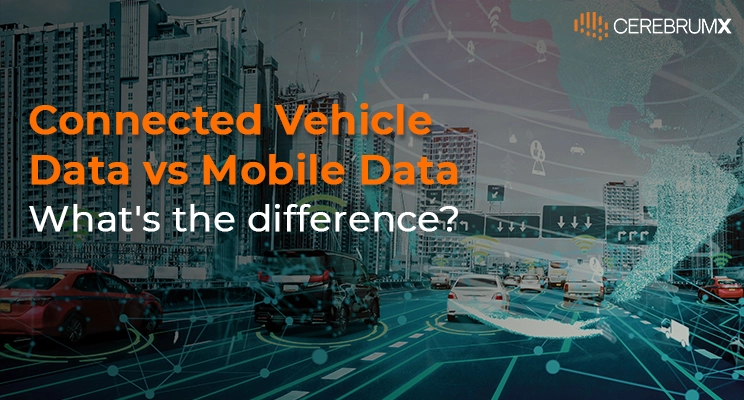Connected Vehicle Data vs Mobile Data, Do you get confused with the difference between Connected Vehicle Data and Traditional mobility Data? Here we go! A car is very different from a smartphone, which requires a higher frequency of data to allow safe and secure driving. Traditional mobility sources such as mobile phones and telematic dongles have multiple drawbacks in connectivity, accuracy, and the sensors available on mobile phones. This article discusses what makes connected vehicle data technology better than mobile data by listing the differences.
What is Connected Vehicle Technology?
Connected vehicle data determines specific variables, including car speed, engine status, user location, if the door is locked, and much more. The data is collected from Controller Access Networks (CANs), Electronic Control Units (ECUs), and Infotainment Systems.
What is Mobile Data?
Mobile data is information derived from smartphones through a wireless cellular connection. It includes data received and transmitted over the internet.
Connected Vehicle Data vs Mobile Data: What’s the difference ?

A smartphone differs from a connected vehicle data technology, wherein the latter uses data to enhance the user experience. It varies in multiple ways. The primary difference between both is that while car data provides elaborate information about various parameters fitted in the car system through GPS and sensors, mobile data merely collects data through GPS. Read below to know more.
Connectivity Issues in Mobile vs Connected Vehicles
Smartphones, when compared to connected vehicles, have higher connectivity issues. For example, a mobile uses the internet and multiple sensors to acquire user data, including location, navigation, etc. On the other hand, the connected vehicle uses antennas and multiple sensors to obtain driver information for converting raw data into intelligent outputs. These include GPS, ultrasonic sensors, fuel sensors, inertial sensors, pressure sensors, RADAR sensors, exhaust gas sensors, video cameras, and much more collect data.
Data Precision & Reliable Data: Connected Vehicle Data vs Mobile Data
Connectivity issues often surface in the case of smartphones affecting data precision. It showcases a positioning error of 4.9 meters compared to 3 meters 95% of the time. Additionally, it can worsen when kept inside a pocket or plugged into OBD ports. A connected vehicle includes GPS connected with an antenna providing the best reception within 3 meters with 95% accuracy.
Data Generation – Intelligent Connected Vehicles vs Mobile Phones
Connected vehicle data is generated through various sensors that help gain multiple insights compared to mobile phones. The details include the number of occupants, trunk access, windscreen wipers, and emergency breaks. This data makes it easier to gain facts about road safety, attendance, HOV lanes, and much more.
Connected Vehicle Data Analytics – Turns Raw Data into Intelligent Connected Vehicle Insights
Connected vehicle insights integrate connected vehicle and real-time data and thereby convert the data into intelligent data. It uses real-time data of the cars, drivers, and environment to optimize and enhance the customer experience. For example, connected vehicle data analytics connects with traffic conditions and weather to better the user’s experience.
Connected Vehicle Data Security vs Traditional Mobility Data Security
Connected Vehicle Data enables maintaining the owner’s safety and privacy. For example, the information users share is entirely secure, allowing them to exercise the entire onus on data control and consent. For instance, CerebrumX’s Connected Vehicle Data prioritizes maintaining complete transparency in exchanging data to prevent misuse. When compared to traditional mobile data security, Connected Vehicle Data ensures integrity, privacy, and confidentiality of information. These include data encryption, employing the cloud for storing sensitive data, secure transport layers, and making operations CCPA and GDPR-compliant.
Benefits: Connected Vehicle Data
Connected vehicle data use cases provide multiple benefits, which include:
- Quick traffic flow management
- Usage-based insurance
- Electric Vehicles
- Driver safety
- Roadside Assistance
Realtime & Historical Data
Mobile phones only use recent data, whereas CerebrumX’s Connected Vehicle Data allows the analysis of high-quality historical data, including road network coverage. It thus enables accurate prediction and forecasting.
High Frequency – Low Latency High-Level Data Sharing
Connected Vehicle Data offers low latency and high-level data sharing systems, improving detection accuracy and user safety. Low latency allows speedy data transfer to obtain timely assistance about the weather, road conditions, traffic, and much more.
Conclusion
CerebrumX’s Connected Vehicle Data analytic Data Platform enables vehicle owners the power of accessing and using the connected car data. Unlock the entire potential of connected vehicle data to enhance your experience with complete security and reliability. Talk to our experts today.


